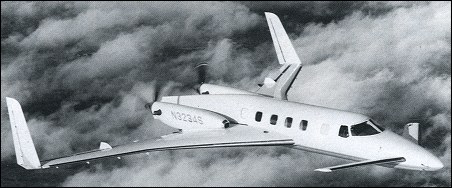 |
Beech Model 2000 Starship1986 |  |
| EXECUTIVE TRANSPORT | Virtual Aircraft Museum / USA / Beech |
 |
To provide a new generation of corporate transports, Beech looked to Burt Rutan's Scaled Composites Inc. to design and produce the SCAT 1, an 85% scale technology demonstrator of a canard-configured aircraft. Success in testing led to the construction of the Model 2000 Starship 1. The Starship design has compound taper main wings, which mount the two pusher engines. Large endplate fins, known as tipsails, provide longitudinal stability, augmented by two small fins on the wing trailing edge. Additional keel area is provided by a ventral fin under the extreme rear of the slender fuselage. The large canard foreplanes of variable-geometry, sweeping forward by 4° for low-speed flight and 30° back in the cruise. Virtually the entire structure is made of Nomex honeycomb and graphite/epoxy composites, with titanium used in high-stress areas. The first of three flying pre-production Starship 1s flew on 15 February 1986. Another three airframes were produced for static, damage tolerance and pressure testing. Basic FAA certification followed on 14 June 1988, and the first production.machine flew on 25 April 1989. This has been used for customer demonstration flights, resulting in 40 orders by June of that year. FACTS AND FIGURES © The lighter weight allowed for a larger cabin than the King Air which was powered by the same engines. © The Starship's engines were mounted in the rear to reduce cabin noise. The main wing was positioned aft to balance lifting forces and mount the engines. © The Starship had two five-bladed, fully feathering, reversible, hydraulically controlled, constant speed, dynamically balanced propellers. © It was believed that composite materials might explode if struck by lightning, so a web of metal wires was inserted between composite layers to act as a Faraday cage and protect the occupants. © Partly to avoid resonance issues, the Starship eschewed a conventional fin and rudder for control surfaces on 'tipsails' at the wingtips.
|  COMPANY PROFILE | ||||||||||||||||||||||||||||||||||||||||||||||||||
 |

|
